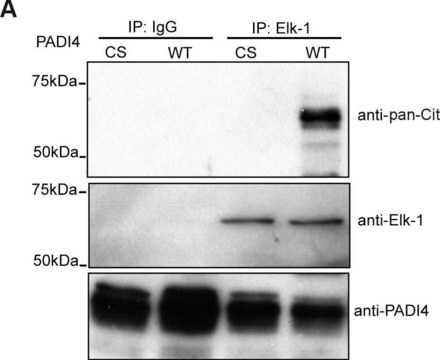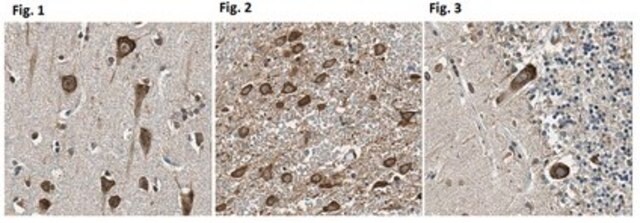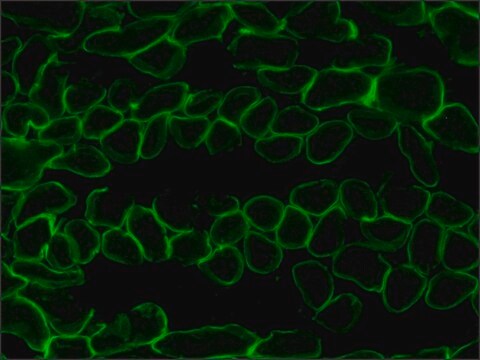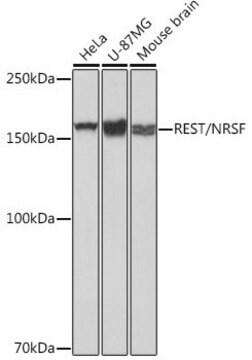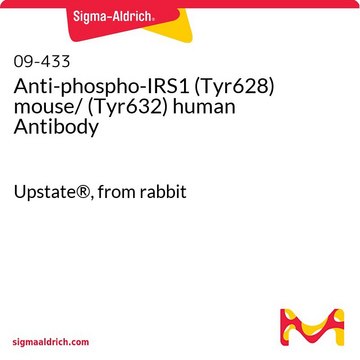推荐产品
生物源
mouse
品質等級
抗體表格
affinity purified immunoglobulin
抗體產品種類
primary antibodies
無性繁殖
16A, monoclonal
物種活性
rat, human
製造商/商標名
Chemicon®
技術
immunocytochemistry: suitable
immunohistochemistry: suitable
western blot: suitable
同型
IgG1
NCBI登錄號
UniProt登錄號
運輸包裝
wet ice
目標翻譯後修改
unmodified
基因資訊
human ... CDH11(1009)
一般說明
Cadherins constitute a family of transmembrane glycoproteins involved in Ca2+-dependent cell-cell interactions. The members of this family are differentially expressed in various tissues. They function in the maintenance of tissue integrity and morphogenesis. The cadherins generally contain five extracellular repeats, a transmembrane domain and a cytoplasmic tail that binds to the catenin family of cytoskeletal anchoring proteins which also function as signal transducers. The extracellular domains are responsible for the specificity of homophilic interactions between cells expressing the same cadherin. Cadherins are divided into type I and type II subgroups. Type I cadherins include epithelial cadherin (E-cadherin, cadherin-1 or uvomorulin), neural cadherin (N-cadherin or cadherin-2), placental cadherin (P-cadherin or cadherin-3) and retinal cadherin (R-cadherin or cadherin-4). Kidney cadherin (K-cadherin or cadherin-6) and osteoblast cadherin (OB-cadherin or cadherin-11) are type II cadherins. The progression of carcinomas is associated with the loss of epithelial morphology and a concomitant acquisition of a more mesenchymal phenotype, which is thought to contribute to the invasive and/or metastatic behavior. A putative role for cadherin-11 in these late stages of tumor progression is based on the fact that migration of mesenchymal cells is facilitated when cadherin-11 is highly expressed.
特異性
Reacts with the extracellular domain of human cadherin-11.
免疫原
Epitope: extracellular domain
Fusion protein corresponding to extracellular domain of human OB-cadherin coupled to GST.
應用
Detect OB-Cadherin using this Anti-OB-Cadherin Antibody, extracellular domain, clone 16A validated for use in WB, IC, IH.
Research Category
Cell Structure
Cell Structure
Research Sub Category
Adhesion (CAMs)
Adhesion (CAMs)
Western blot: 1:25 - 1:250
Immunohistochemistry: Frozen tissue sections. 1:25 - 1:50 dilution using avidin-biotinylated horseradish peroxidase complex (ABC) as detection protocol.
Immunocytochemistry: Methanol and paraformaldehyde-fixed cells
Optimal working dilutions must be determined by the end user.I/
Immunohistochemistry: Frozen tissue sections. 1:25 - 1:50 dilution using avidin-biotinylated horseradish peroxidase complex (ABC) as detection protocol.
Immunocytochemistry: Methanol and paraformaldehyde-fixed cells
Optimal working dilutions must be determined by the end user.I/
外觀
Affinity purified immuoglobulin. Liquid in PBS containing 0.09% sodium azide.
Format: Purified
儲存和穩定性
1 year at 4°C from date of shipment
其他說明
Concentration: Please refer to the Certificate of Analysis for the lot-specific concentration.
法律資訊
CHEMICON is a registered trademark of Merck KGaA, Darmstadt, Germany
免責聲明
Unless otherwise stated in our catalog or other company documentation accompanying the product(s), our products are intended for research use only and are not to be used for any other purpose, which includes but is not limited to, unauthorized commercial uses, in vitro diagnostic uses, ex vivo or in vivo therapeutic uses or any type of consumption or application to humans or animals.
未找到合适的产品?
试试我们的产品选型工具.
儲存類別代碼
12 - Non Combustible Liquids
水污染物質分類(WGK)
WGK 2
閃點(°F)
Not applicable
閃點(°C)
Not applicable
Ziqiang Teo et al.
Scientific reports, 7(1), 6303-6303 (2017-07-26)
In adult skin wounds, collagen expression rapidly re-establishes the skin barrier, although the resultant scar is aesthetically and functionally inferior to unwounded tissue. Although TGFβ signaling and fibroblasts are known to be responsible for scar-associated collagen production, there are currently
Sook Kyung Chang et al.
The Journal of clinical investigation, 127(9), 3300-3312 (2017-08-02)
M2 macrophages, innate lymphoid type 2 cells (ILC2s), eosinophils, Tregs, and invariant NK T cells (iNKT cells) all help to control adipose tissue inflammation, while M1 macrophages, TNF, and other inflammatory cytokines drive inflammation and insulin resistance in obesity. Stromal
我们的科学家团队拥有各种研究领域经验,包括生命科学、材料科学、化学合成、色谱、分析及许多其他领域.
联系技术服务部门